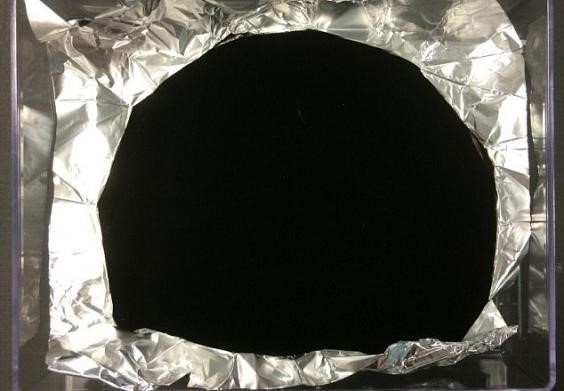
Have you ever seen a substance so black that the human eye can’t understand what it’s seeing, making crumbled objects painted with it appear flat? I’m not talking about black holes, which aren’t visible to the naked eye, but a material called Vantablack — a synthetic compound developed by British company Surrey NanoSystems to be the blackest material ever. Vantablack absorbs 99.96% of the light that strikes its surface.
“[After coating aluminum foil in Vantablack,] you expect to see the hills and all you can see … it's like black, like a hole, like there's nothing there. It just looks so strange,” Ben Jensen, chief technical officer of Surrey Nanosystems, told the Independent back in July 2014 when the original Vantablack was released. Since then, its increased its light absorption rate of 99.85% to the current 99.96%.
But what happens when you shine some laser on it? Ordinarily, light reflected from the laser produces a circle of light at the point of contact between the beam and the object. But when engineers from Surrey NanoSystems traced a laser on Vantablack, the light simply disappeared, as if swallowed by a black hole. Almost nothing detectable was reflected back to our eyes.
Don’t believe me? Check out the video below to see for yourself.
Scientists created Vantablack by tightly packing carbon nanotubes — each 10,000 times thinner than a human hair — on a sheet of aluminum so close together that the light that goes in gets trapped in the tiny spaces between the tubes. As with most super-black materials, Vantablack’s primary function is to calibrate cameras used to photograph celestial objects in space. Research groups, including NASA, have long worked to make dark blacks that could help calibrate super-sensitive infrared cameras.
Vantablack also absorbs 99.85% of infrared radiation.
Unlike other substances in the super-dark category, Vantablack’s carbon nanotubes don’t require as high of temperatures to construct, meaning that engineers may deposit it on a wider range of substances. The material conducts heat seven-and-a-half times more effectively than copper, with 10 times the tensile strength of steel.
Advertisement
Learn more about Electronic Products Magazine





